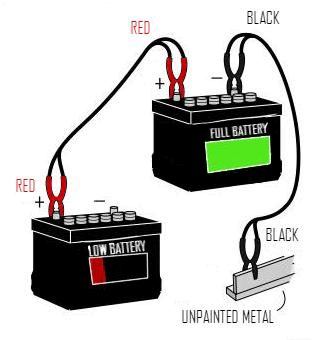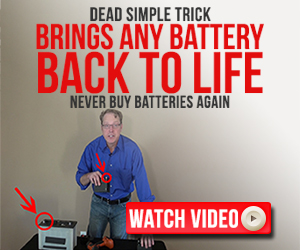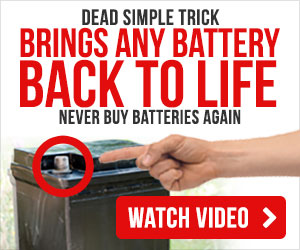In this article, we’ll share some tips and tricks with you if your car won’t start. We’ll help you diagnose what’s wrong and more importantly, we’ll show you what to do to get your car to start!
Even if your car is able to start right now, the simple skills we teach in this article are good to learn so you’re prepared the next time you’re in a rush somewhere or you’re trying to get somewhere important but your car is dead.
It’s also a good idea to bookmark this page right now so you can get back to it quickly in the future if your car ever dies at a bad time…
This article is going to show you a few simple steps you can take to immediately diagnose the car’s problem and get it to start again.
We break this report up into four sections:
- First Three Sections: In these sections, we teach the common symptoms you may notice when your car won’t start. If your car has one of these symptoms, then you should use the cures we teach in that section to get your car to start.
- Last Section: If the problem is that your car’s battery is dead, we included this last section for you. We noticed that a lot of people online teach a wrong (or even unsafe) way to jump start a car. So we’re teaching the correct (and safe) way to jump start your car in this last section!
So before calling a tow truck, try the tips and tricks in this article. They may save you some money and get your car to start on the spot!
#1 SYMPTOM: CLICKING NOISE WHEN KEY IS TURNED IN THE IGNITION
When the key is turned in the ignition there is a clicking sound but the car won’t start.

Diagnosis: This is usually caused by a weak battery, dirty battery terminals, a worn starter motor or a stuck solenoid. To isolate if it’s related to the battery, turn on the vehicle cabin light and try and start your car. If the light goes out during this, the battery is extremely weak.
#1 Cure: The first method is to heat up the battery, terminals and starter. To do this, try and turn on the car ignition ten time consecutively then let it rest for 5 minutes. Then turn it on again. If the car still won’t start but the vehicle’s cabin light is strong try another method.
#2 Cure: Pop the hood of your car and tap on the battery terminals so that they turn a little. Or jar the battery terminals so they make contact with the battery properly. Then try and start the engine again.
#3 Cure: In vehicles where you have access to the motor’s starter, try tapping on it with your tire iron. The electrical contacts may have gotten stuck and tapping on them in this way can dislodge electrical contacts.
#2 SYMPTOM: NO CLICKING NOISE WHEN THE KEY IS TURNED IN THE IGNITION
When the key is turned in the ignition and there is no clicking sound and the car won’t start.
Diagnosis: Electrical contact is not established inside the transmission range selector.
Cure: While you press with your foot on the brake pedal move the shift lever to “Neutral”. Try starting up the engine again. If you do not have success at first, move it back to “Park” and repeat the process again. Moving the shifter will sometimes reestablish electrical contact inside the transmission range selector.
#3 SYMPTOM: THE ENGINE CRANKS BUT THE CAR WON’T START
When you turn the key in the ignition the car cranks up but not enough to run the motor.
Diagnosis: First turn off the vehicle’s lights and radio. Turn the key in the ignition to the “Run” position. You will hear a 2 sec whizzing sound. The fuel pump will be priming the injection system. If no sound is heard the fuel pump relay is not working or working very poorly.
#1 Cure: Hit the bottom of the fuel tank in succession with an object that will not cause damage. Anything covered with rubber or a flexible material that can absorb sharp vibrations (e.g. the heel of your shoe) should work well. Jarring the fuel pump may help get the car engine started again. If this works, that means there is a 99% chance your motor will need to be replaced soon. The reason this may get your car to start again is because when an electric motor gets old, the armature can stop rotating properly. And banging the fuel tank can jar the armature to get it working again (at least for a little bit).
#2 Cure: If you smell gas the engine may be flooded. In this case, press the accelerator pedal to the floor and keep it steady, then turn the key. DO NOT pump the peddle or you will flood the carburetor again. If you have a carbureted car, this opens the throttle and also the choke a bit. Doing this, sends in a lot of air to help un-flood the engine. And if you have a fuel injected car, this also works because you’re letting the car’s computer know that the engine is flooded. So the car’s computer will automatically cut the fuel flow dramatically.
#3 Cure: This next cure isn’t an instant fix for your car (and is a little more advanced) but we thought it was still worth mentioning. Take a look at your owner’s manual to find the location of the fuel pump relay. Or it can also be found on the legend of the under-hood fuse box cover. Once you find it, pull the fuel pump relay straight up. You will then have to find another relay with the same part number and exchange it with the fuel pump by pushing it straight down the socket. Start the engine after trying this.
#4 Cure: Last resort is to trick the computer. A vacuum leak or a temperature sensor that is not working correctly results in an air/fuel mixture that’s too weak to startup a cold engine. Press down halfway on the accelerator and start the engine. That method will trick the computer into adding more fuel.
HOW TO JUMP START A CAR
If your car is simply not starting because your battery is dead, we wanted to also include these simple instructions for how to PROPERLY jump start your car.
We actually see incorrect information regarding this online sometimes. So make sure you follow these correct (and safe) instructions to get your car to start if your battery is dead…
Here are safe instructions on how to jump start a car:
#1 You will need a set of jumper cables. Store them in your car for emergencies.
#2 Call a friend or someone to help with this procedure because you will need someone to bring over a second car. Both cars are to be in “Park” or “Neutral” with ignitions off and emergency brakes on.
#3 Remove the caps from unsealed batteries. Explosive hydrogen gas is produced in batteries and a spark could set it off. With the caps off there cannot be a hydrogen gas build up and an explosion is averted. Sealed batteries have safety valves so no caps need to be removed on these.
#4 You will next connect the jumper cables from your dead battery to the other car’s battery. The RED CLIPS of the jumper cables are at either ends of the POSITIVE cable and the BLACK CLIPS are at either ends of the NEGATIVE cable. The order of attachment is important so please pay attention to the next steps.
#5 FIRST attach the red clip to the POSITIVE terminal of your battery. Identifying the POSITIVE terminal is easy – it will either have “POS” or “+” on it OR it will be the bigger terminal (and the negative terminal will be smaller).
#6 The other end with the red clip will be attached to the POSITIVE terminal of your friend’s or helper’s car.
#7 Next, proceed to attach one of the black clips to the NEGATIVE terminal on your friend’s or helper’s car. The other black clip must be attached to a metal unpainted surface on your car that isn’t near the carburetor (if your car has one) or the battery.
View Diagram 1 below:

#8 Start your vehicle. If it is not starting, check the jumper cables and make sure they’re connected correctly. Then have your friend or helper run their car engine for five minutes. Next, try starting your car again. If this does not work for you then your car battery needs to be reconditioned or replaced.
#9 If this procedure did help your car start, do not shut off your engine right away. Instead, drive for while to give the battery the opportunity to recharge.
EXTRA TIP: If the alternator light stays on OR if the the gauge on the dashboard continues to show “Discharge” after the car has been running, tighten the fan belt so that the alternator can run properly. If you keep having trouble with your battery going dead you will need a professional to check on the battery and the alternator.
WARNING: If the light on the gauge reads “Warning” check it out immediately and don’t drive around with the warning signal on – act on it. That’s the purpose of the gauges – to protect you!
I hope you found this article helpful! Now you know what to do the next time your car won’t start.
Has your car ever died at a bad time? What did you do to get it started? Comment below…



4 replies to "What To Do If Your Car Won’t Start"
My car battery died when I was going to a job interview once. I got it jump started but was a bit late.
This is a great guide. Wish I had this then.
Helpful tips. Thanks
I pulled this article up on my phone when my car wouldn’t start. Super helpful.
I am very happy to have this information about jump starting a car.